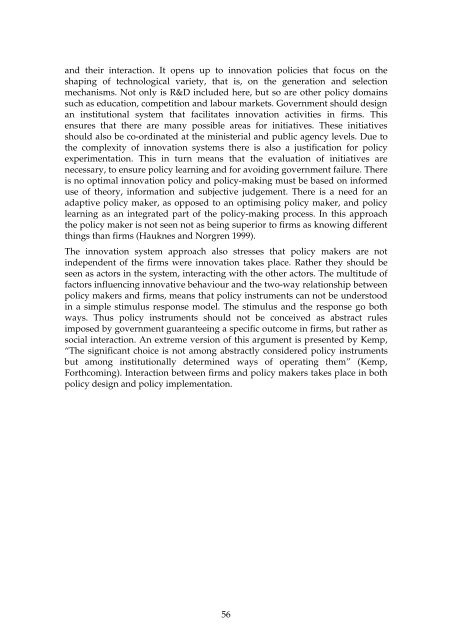Drivers of environmental innovation - Vinnova
Drivers of environmental innovation - Vinnova
Drivers of environmental innovation - Vinnova
Create successful ePaper yourself
Turn your PDF publications into a flip-book with our unique Google optimized e-Paper software.
and their interaction. It opens up to <strong>innovation</strong> policies that focus on the<br />
shaping <strong>of</strong> technological variety, that is, on the generation and selection<br />
mechanisms. Not only is R&D included here, but so are other policy domains<br />
such as education, competition and labour markets. Government should design<br />
an institutional system that facilitates <strong>innovation</strong> activities in firms. This<br />
ensures that there are many possible areas for initiatives. These initiatives<br />
should also be co-ordinated at the ministerial and public agency levels. Due to<br />
the complexity <strong>of</strong> <strong>innovation</strong> systems there is also a justification for policy<br />
experimentation. This in turn means that the evaluation <strong>of</strong> initiatives are<br />
necessary, to ensure policy learning and for avoiding government failure. There<br />
is no optimal <strong>innovation</strong> policy and policy-making must be based on informed<br />
use <strong>of</strong> theory, information and subjective judgement. There is a need for an<br />
adaptive policy maker, as opposed to an optimising policy maker, and policy<br />
learning as an integrated part <strong>of</strong> the policy-making process. In this approach<br />
the policy maker is not seen not as being superior to firms as knowing different<br />
things than firms (Hauknes and Norgren 1999).<br />
The <strong>innovation</strong> system approach also stresses that policy makers are not<br />
independent <strong>of</strong> the firms were <strong>innovation</strong> takes place. Rather they should be<br />
seen as actors in the system, interacting with the other actors. The multitude <strong>of</strong><br />
factors influencing innovative behaviour and the two-way relationship between<br />
policy makers and firms, means that policy instruments can not be understood<br />
in a simple stimulus response model. The stimulus and the response go both<br />
ways. Thus policy instruments should not be conceived as abstract rules<br />
imposed by government guaranteeing a specific outcome in firms, but rather as<br />
social interaction. An extreme version <strong>of</strong> this argument is presented by Kemp,<br />
“The significant choice is not among abstractly considered policy instruments<br />
but among institutionally determined ways <strong>of</strong> operating them” (Kemp,<br />
Forthcoming). Interaction between firms and policy makers takes place in both<br />
policy design and policy implementation.<br />
56

















